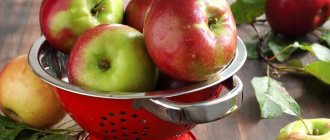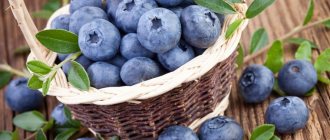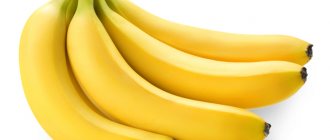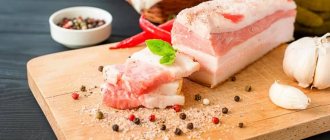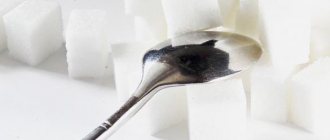What is the nutritional value of bananas?
The fruit contains a small number of calories - up to 120 (medium-sized fruit). It saturates the body well and promotes the active development of muscle mass, which is necessary during sports training and for those who want to lose weight. But if you have diabetes, bananas should be consumed with caution. Research by specialists has shown that the fruit contains micronutrients of groups A, B, C, D. Its structure also includes microelements useful for the human body • iron; • potassium; • calcium.
IMPORTANT! The fruit contains a low amount of sodium and saturated fat compounds, but a high level of glucose. Therefore, whether it is possible to eat bananas with diabetes mellitus should be determined by the attending physician, based on the individual characteristics of the body and the complexity of the disease.
One small fruit of the plant can restore 30% of vitamin B6 from the daily requirement. The body receives 20% of the required amount of micronutrient C, 16% manganese, 13% potassium and 8% magnesium. The attention of scientists was attracted by substances such as catechins and dopamines. Recent studies have shown that dopamine, which is the foundation for the formation of the joy hormone, is not able to penetrate the human brain. Therefore, bananas cannot be classified as valuable products that improve a person’s mood. Catechins are powerful antioxidants that suppress free radicals that contribute to the development of various diseases, including cancer and cardiovascular pathologies.
Banana: vitamin and mineral content
One medium banana covers 25-30% of the daily requirement for vitamin B6, important for metabolism, 12-15% of the daily requirement for vitamin C, 16% of the daily requirement for manganese, 12% for potassium and 8% for magnesium. Depending on where they grow, bananas may contain some iron, copper and selenium.
Bananas also contain antioxidants catechins and natural dopamine. Even though the dopamine from bananas cannot reach the brain (it is a myth that bananas improve your mood and fight depression), these natural substances successfully fight free radicals.
How many grams of sugar and other substances are in 1 banana?
Analysis of the composition of the fruit shows that the leader in the weight category among carbohydrates is sugar. The average fruit contains up to 16 g. In the second position there is another carbohydrate - starch, 6 g, in the third - fiber, 3.5 g. In total, the product contains fats, proteins and carbohydrates, respectively: • 0.4 g; • 1.4 g; • 31 g. Among the microelements, potassium stands out. Its amount reaches 480 mg. In most cases, bananas end up on a person’s table from a store. Before this, they go through several stages of processing, which affects the amount of sugar. Delivery of fruit to retail outlets is carried out in special vacuum packaging materials, which are stored in refrigerators at a temperature of 10 to 13°C.
Before reaching store shelves, the fruits are restored. For this purpose, substances that accelerate ripening are used. After which they go on sale. During storage, the berries continue to ripen. The unnatural ripening process causes a significant increase in the amount of sugar in the banana.
Harm of bananas
Eating bananas is not recommended for people with irritable bowel syndrome, as they can aggravate the disease. According to Harvard Health Publications
, bananas can cause food allergies and unpleasant bloating in certain people.
In addition, in a certain (fairly small) number of people, bananas can increase blood viscosity, which, in turn, reduces blood flow to parts of the body. This is dangerous for those suffering from varicose veins, and can also negatively affect male potency.
Can you eat bananas if you have diabetes?
The fruit has an average glycemic index. Its performance depends on the degree of maturity. In green fruit it is equal to 30 units, in ripe fruit it can reach 60. Despite these characteristics, there is no categorical ban on the use of the product. Therefore, diabetics should not exclude bananas from their diet.
You need to adhere to one important rule - use them in limited quantities as prescribed by the doctor. Bananas for type 2 diabetes can be dangerous for humans. Domestic specialists from the diabetic association advise introducing berries into the diet of patients in a special way.
The benefits and harms of bananas for diabetics
For people with diabetes, it is very important to maintain a feeling of fullness after eating without unnecessary stress on the endocrine system. Banana copes well with this problem. However, uncontrolled consumption of the fruit can lead to a worsening of the disease. Normally, it stimulates the activity of the nervous system and normalizes blood pressure. Pectins have a positive effect on the growth of beneficial microorganisms involved in food digestion.
Also, eating the fruit improves: • skin condition; • brain functioning; • activity of the musculoskeletal system.
The main disadvantage of a banana is the sugar content that exceeds the norm in a ripe fruit, and the cholesterol content in green fruit. If a diabetic has concomitant diseases, such as irritable bowel syndrome, food allergies, the fruit will lead to a worsening of the condition.
Regular consumption of bananas may increase blood viscosity, which leads to a deterioration in blood flow in the system. This can pose a great danger to the patient. It is strictly prohibited to consume industrial bananas. After all, they are treated with carcinogenic substances that can cause damage to health. A high-quality product in an acceptable quantity will only contribute to the normal functioning of all body systems.
Source: fructify.ru
How to eat fruit correctly when dieting?
If you have diabetes, you should strictly monitor the amount of carbohydrates in each serving. The small fruit weighs approximately 30 g. This suggests that it can be used as a snack. If you plan to consume additional sources of carbohydrates - bread, porridge, then the portion of banana should be reduced in accordance with the norm.
Important! The fruit, along with some saturated fats (almond butter, nuts), can lower blood sugar.
The patient is often recommended to eat the fruit along with foods containing a lot of protein. The best combination is walnut yogurt or turkey meat.
An overripe banana almost always increases blood sugar. Green fruit in small quantities does not allow glucose to go beyond the normal range due to the presence of resistant starches. But doctors still do not recommend getting carried away with green bananas. If desired, it is better to limit yourself to small fruits. Mostly they contain up to 23 g of carbohydrates. As for large fruits, they contain 35 g of carbohydrates.
The amount of banana that a diabetic is allowed to consume per day depends on: • the complexity of the disease and its type; • individual characteristics of the body; • human activity.
If the patient is sensitive to substances contained in bananas, then it is better to completely exclude them from the diet. In other cases, it is important for a diabetic to know exactly how the fruit affects his body. This will help manage insulin levels and monitor medications. Statistics show that you can eat a sweet product once a day without harm. In this case, the fruit should be small in size.
Possible harm and contraindications
A healthy exotic fruit can be harmful to a patient with diabetes if contraindications and warnings from doctors are not taken into account. It is especially necessary to monitor the diet of pregnant women diagnosed with diabetes. Bananas can quickly raise glucose levels, which is dangerous for decompensated diabetes.
Possible harms of banana snacks and desserts:
- this is a difficult product to digest in diabetes mellitus and often provokes bloating and a feeling of heaviness in the stomach;
- when combined with sweet apples, pears and sugar, banana desserts not only become high in calories, but also cause an increase in sugar levels, then in body weight, leading to obesity;
- In case of diabetes mellitus in the stage of decompensation, overripe bananas can sharply cause an unstable increase in sugar levels.
Bananas are prohibited for diabetics if:
- there are non-healing wounds and ulcers on the body;
- there is a rapid gain of body weight in a short period of time;
- atherosclerosis was diagnosed, blood vessel diseases were identified.
Important! If you have diabetes, it is forbidden to eat dried bananas in the form of candied fruits or dried fruits due to their high calorie content (about 340 kcal per 100 g of product). Banana peels should also not be eaten.
A banana included in a diabetic diet will do more good than harm only if consumed in moderation. Eating a lot of it will cause your blood sugar levels to increase. The best option is to eat 3-4 mugs at a time, dividing the whole fruit into several doses.
The benefits and harms of bananas for patients with diabetes
Share this article
Source: diabay.ru
The whole truth about bananas
Bananas will not save you from drugs, cigarettes and alcohol. But they can still do something.
What do we know about bananas? Before reading this material, I only knew about bananas that they are an excellent source of quick energy for our body. But you will be surprised how much these fruits hide in themselves.
Bananas contain three types of sugar - sucrose, fructose and glucose. As I said, they provide an almost instantaneous boost of energy due to the sudden release of insulin. However, this is not their only advantage.
Bananas can also serve as a preventative against certain diseases.
However, many publications on the Internet speak too highly of bananas, attributing to them properties such as the prevention of depression, fatigue, stress and other diseases. Although, in our opinion, even when comparing bananas with cookies, it is difficult to choose a favorite, so we decided to figure out what's what.
Depression
According to studies conducted by the MIND Research Institute, many patients felt slightly better after eating bananas. This is because bananas contain high amounts of tryptophan, a type of protein that the body converts into serotonin. Serotonin is a hormone responsible for calm, relaxation and your mood.
Lie
Tryptophan is an amino acid found in all proteins. The level of tryptophan in bananas is very low and it makes no sense to say that it can affect your mood. Even the fact that brightly colored bananas make you happier is more likely than that.
Anemia
Bananas contain a large amount of iron, which stimulates the production of hemoglobin in the blood and prevents anemia.
Blood pressure
Bananas contain high amounts of potassium, which has a positive effect on blood pressure and reduces the likelihood of high blood pressure and heart strokes.
Is it true
One large banana contains approximately 500 mg of potassium, which is slightly more than 10% of the daily value for this substance.
Mental activity
During exams, 200 students at the British school Twickenham ate bananas several times a day. Studies have shown that due to its high potassium content, this fruit enhances attention and improves brain function.
Constipation
Due to their high fiber content, bananas restore normal bowel function, helping to overcome constipation without resorting to laxatives.
Hangover
One of the best ways to fight a hangover is to drink a banana milkshake with honey. Bananas reduce headaches, and honey balances blood sugar levels. While milk calms the body and restores fluid levels.
It is not clear on what basis these conclusions were made, so we need volunteers who are ready to test this for themselves



